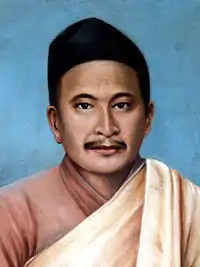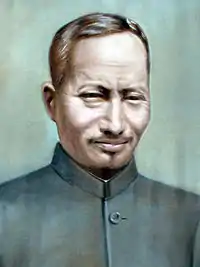Four Pillars of Nepal Bhasa
Four Pillars of Nepal Bhasa (Newar: नेपाल भाषाया प्यंगः थां) are the four leaders who spearheaded the campaign to revive the Newar language and its literature during the repressive Rana regime,[1] and guided its renaissance at the beginning of the 20th century.[2]




They produced literature at the risk of personal freedom and laid the foundation for the development of modern Nepal Bhasa. Their work marks the beginning of the Nepal Bhasa movement in Kathmandu, which has led to greater rights in education, the media and official recognition.
The four figures honored as the four pillars of the Nepal Bhasa renaissance are author Nisthananda Bajracharya, poet Siddhidas Mahaju, educationist Jagat Sundar Malla and poet Yogbir Singh Kansakar.
Nisthananda Bajracharya
Nisthananda Bajracharya (1858 - 1935) marked a turning point by breaking away from the classical style and writing prose in colloquial language. In 1909, Bajracharya published Ek Bishanti Prajnaparamita, the first book in Nepal Bhasa to be printed with moveable type. Lalita Vistara, his most famous work which is based on the Buddha's life story, and Swayambhu Purana were published in 1914.[3][4]
Siddhidas Mahaju
Siddhidas Mahaju (alternative name: Siddhidas Amatya) (1867 - 1929) was at the forefront in the endeavour to revive literature in Nepal Bhasa. He has been honored with the title Great Poet. Mahaju wrote more than 44 books of poetry, epics, short stories and essays. Sajjan Hridayabharan, a book of poems on morals which came out in 1920, was the only one published during his lifetime. Mahaju composed Siddhi Ramayana, a translation of the epic Ramayana in Nepal Bhasa, in 1913.[5][6]
Jagat Sundar Malla
Jagat Sundar Malla (1882 - 1952) was a teacher and writer who dedicated his life to the education of the common people. In 1913, Malla opened a school in his home defying government disapproval. He stressed the importance of learning English, and he wrote and published textbooks in Nepalese languages as he believed that children learn faster if they are taught in their mother tongue.[7][8]
Yogbir Singh Kansakar
Yogbir Singh Kansakar (alternative name: Jogbir Singh Kansakar) (1885 - 1942) was a poet and social reformer who worked to develop his mother tongue and promote Buddhism. In 1929, Kansakar headed a committee which petitioned the prime minister to be allowed to open a library for which he was arrested and fined. He has also been publicly flogged for his reformist activities.[9] An anthology of Kansakar's poems entitled Yog-Sudha was published by Nepal Bhasa Parishad in 1951.[10]
References
- Lienhard, Siegfried (1992). Songs of Nepal: An Anthology of Nevar Folksongs and Hymns. New Delhi: Motilal Banarsidas. ISBN 81-208-0963-7. Page 1.
- Shrestha, Durga Lal (2000). Twists and turns: A pick of Durga Lal Shrestha's poems. Kathmandu: Mandala Book Point. Page viii.
- LeVine, Sarah and Gellner, David N. (2005) Rebuilding Buddhism: The Theravada Movement in Twentieth-Century Nepal. Harvard University Press. ISBN 978-0-674-01908-9. Page 258. Retrieved 9 October 2012.
- Gellner, David N. "Language, Caste, Religion and Territory: Newar Identity Ancient and Modern". Retrieved 9 October 2012. Page 129.
- "Contributions to Nepalese Studies, Volume 22". Institute of Nepal and Asian Studies, Tribhuvan University. 1995. Missing or empty
|url=(help) Page 74. - Tuladhar, Prem Shanti (2000). Nepal Bhasa Sahityaya Itihas: The History of Nepalbhasa Literature. Kathmandu: Nepal Bhasa Academy. ISBN 99933-56-00-X. Page 84.
- Adams, Barbara (2004). "Master Jagat Sundar Malla: A prophet before his time". Barbara's Nepal. Adroit Pub. Retrieved 9 October 2012.ISBN 8187392444.
- Hoek, Bert van den; Shrestha, Bal Gopal (January 1995). "Education in the Mother Tongue: The Case of Nepal Bhasa" (PDF). CNAS Journal. Retrieved 9 October 2012. Page 74.
- Sthavir, Dharmalok (1 December 1977). "A Journey to Great China". Regmi Research Series. Regmi Research. Retrieved 30 March 2012. Pages 35-36.
- Dali, Indira (1991). "Libraries and information centres" (PDF). Libraries and information centres in Nepal: CEDA library and documentation branch. Singapore: Asian Mass Communication Research & Information Centre. Retrieved 9 October 2012. Page 17.